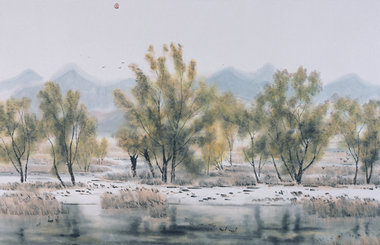A portal to an ancient world
By Yang Feiyue ( China Daily ) Updated: 2015-07-11 08:15:44
 |
|
A live reenactment of the panoply when Emperor Kangxi came to visit in the Prime Minister's Palace in Jincheng. [Photo by Wang Zhuang Fei/China Daily] |
From aged city walls to Ming dynasty-era buildings, Pingyao and its surrounding scenic areas provide a glimpse into China's past.
Go to Shanxi if you want to get a good measure of China's ancient civilization.
While the rest of China aims to present the world a new face, Shanxi wants nothing but to showcase Chinese culture that dates back 5,000 years ago, says Wang Wenbao, deputy director of Shanxi tourism bureau.
Myriads of densely-populated ancient buildings viewed from the top of the Pingyao ancient city wall can easily take one's breath away. The city sits in Jinzhong city, which is half an hour away from Shanxi's capital city Taiyuan by high-speed train.
"There are roughly 4,000 well-preserved residences of Ming and Qing dynasties (1368-1911) within the city wall," says Cao Xin, a local tour guide.
What makes Pingyao special is its intact city wall that runs approximately six kilometers, Cao claims. It takes one two hours to walk the full circle of the wall and enjoy a bird's eye view of what's inside.
"Unlike other historical sites under strict protection but suffer the loss of the human touch, the ancient city is very much alive, thanks to its inhabitants," Cao says.
One can find ancient government offices, banks and temples in the city, and give free rein to their imagination of how Chinese ancestors go around their daily life.
The place that houses ancient torture tools and displays photos showing how criminals were punished boggles the mind. It makes me realize that ancient justice did know how to knock the stuffing out of the convicted and let them suffer till sweet death came.
The World Heritage Committee has rated the city as the best-preserved ancient county in China and an outstanding example of Han nationality cities of Ming and Qing dynasties. The committee held that the city offers a complete picture of cultural, social, economic and religious development in ancient times.
Those who want to shop shouldn't miss yellow rice wine, local lacquer and Chinese yams, the three treasure of the city, Cao says. She explains that although some products cost more in the scenic spots, they are well worth it.
"The Changshengyuan yellow wine that was loved by Empress Dowager Ci Xi (1835-1908) and Yonglong lacquer are only available for sale here. You can't buy them elsewhere."
The city takes on the look of Beijing's Nanluoguxiang when night falls. The street here is wider and more comfortable for one to walk through.
Red lanterns hanging from the eaves are lit. Bars and restaurants bustle with business.
A ticket to Pingyao costs 120 yuan from March to October and will drop to 90 yuan for the rest of the year, Cao says.
|
|
|
|
|
|
|
|

























 Raymond Zhou:
Raymond Zhou: Pauline D Loh:
Pauline D Loh: Hot Pot
Hot Pot Eco China
Eco China China Dream
China Dream China Face
China Face






